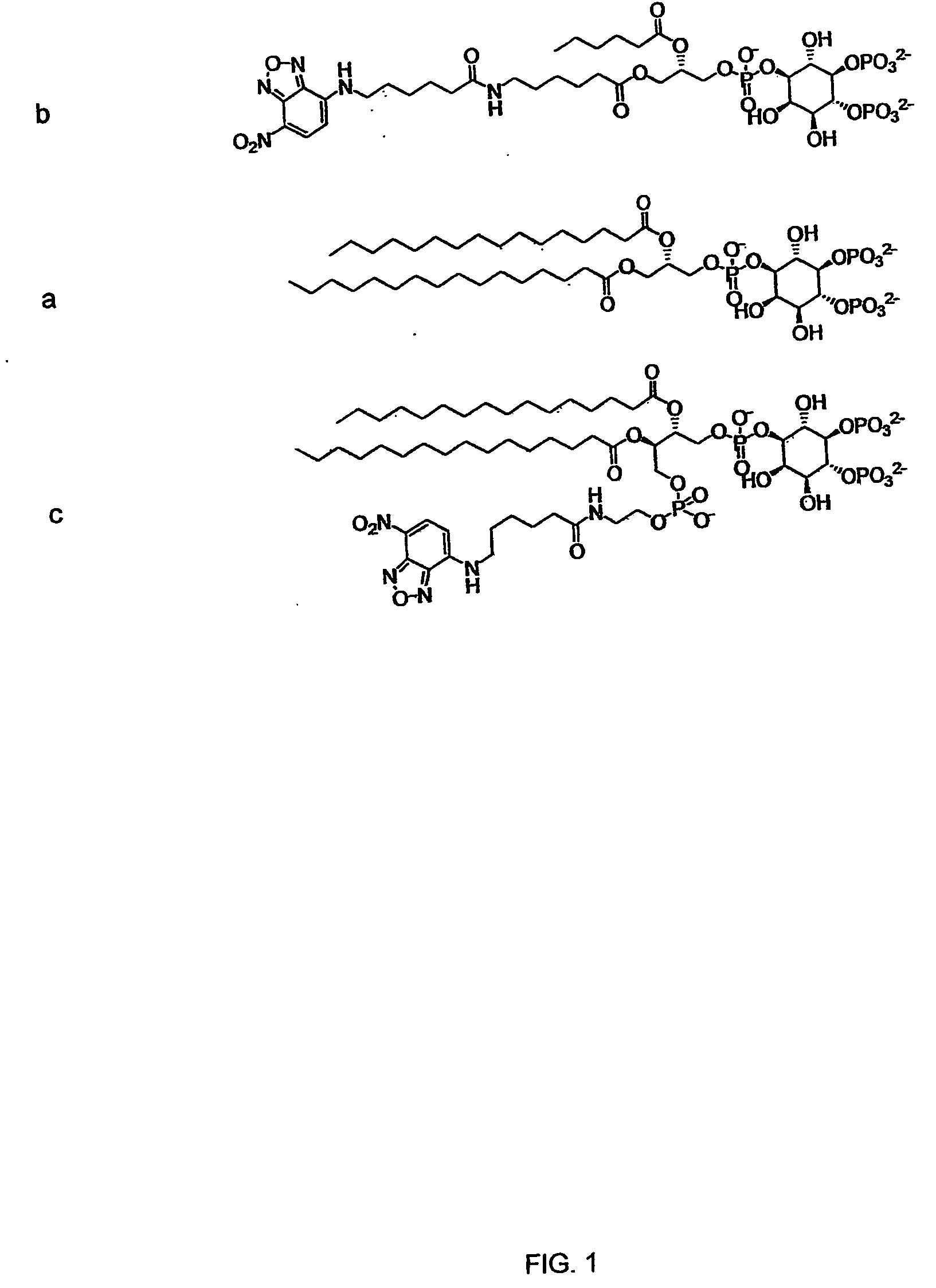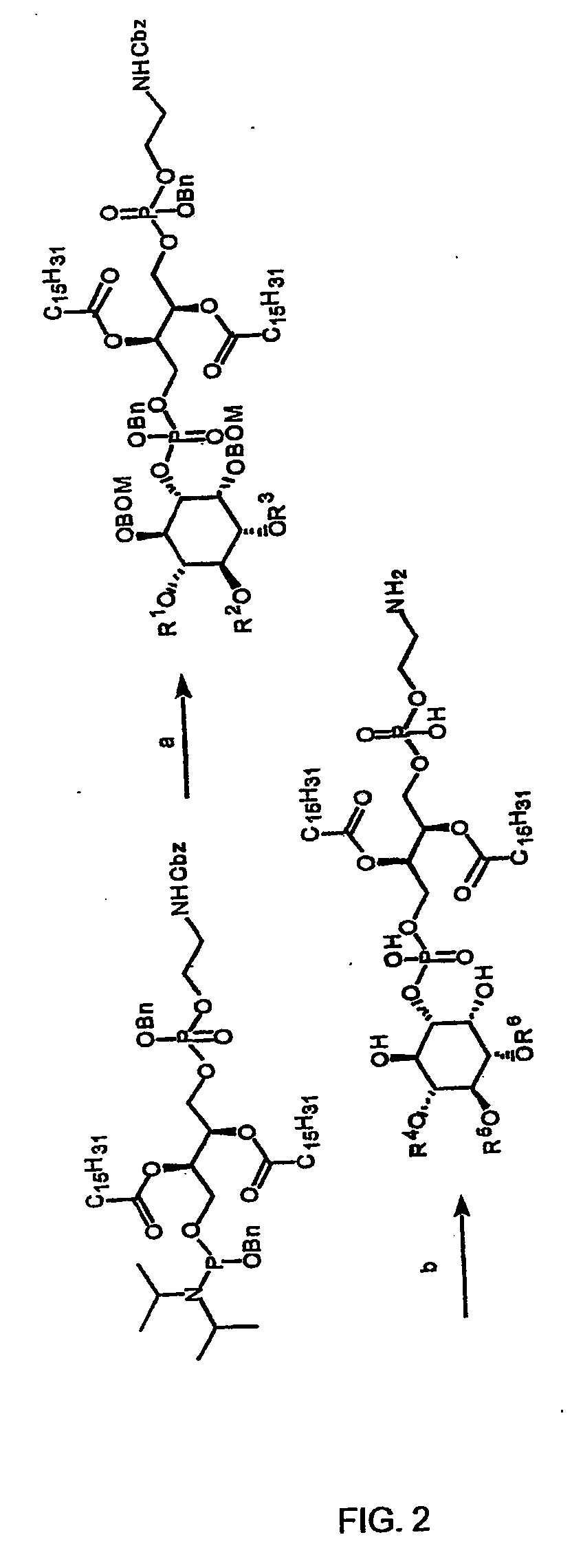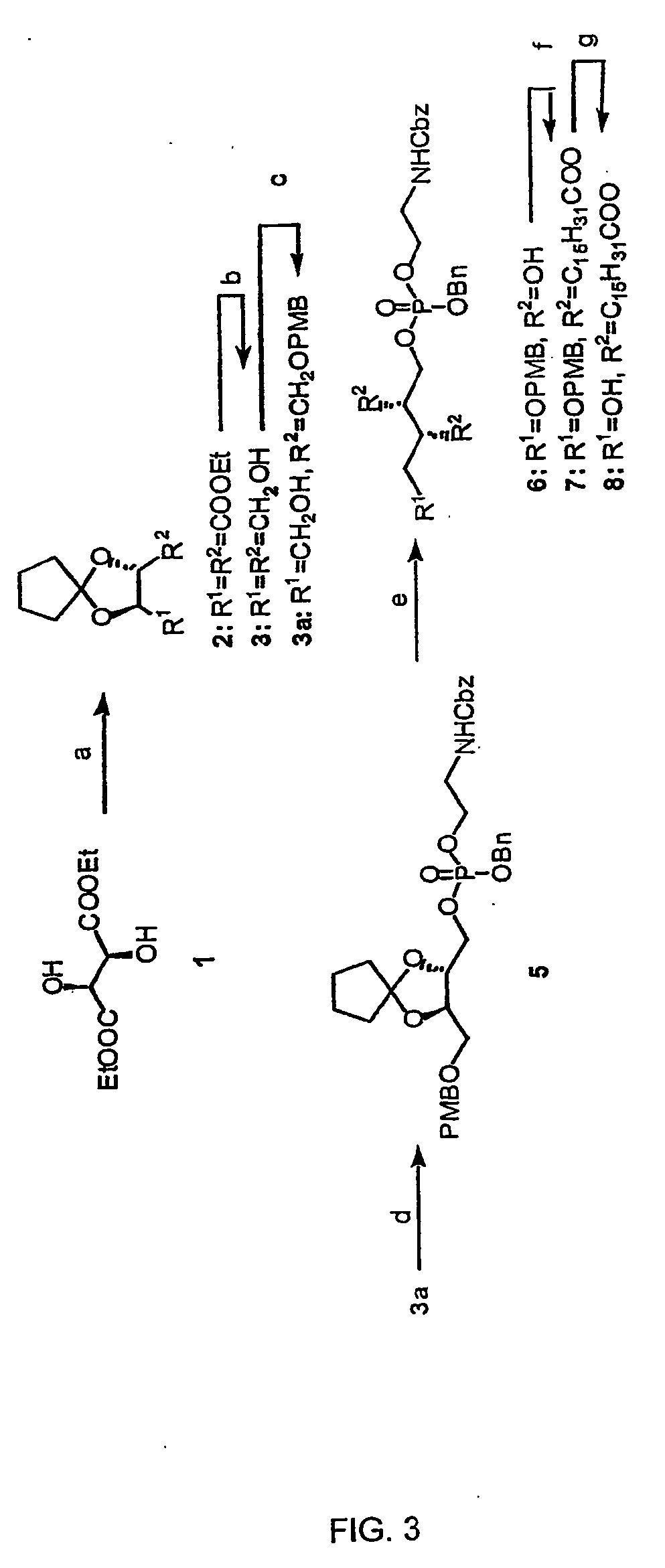Hybrid phosphoinositide phospholipids: compositions and uses
a technology of phosphoinositide and phospholipid, which is applied in the direction of peptides, peptide/protein ingredients, peptide sources, etc., can solve the problems of many acyl-modified phosphoinositides not showing adequate k/sub>m /sub> and v/sub>max /sub>values as substrates for lipid kinases, and achieve the effect of facilitating the recruitment of p
- Summary
- Abstract
- Description
- Claims
- Application Information
AI Technical Summary
Benefits of technology
Problems solved by technology
Method used
Image
Examples
example 1
Synthesis of Functionalized Phosphoinositide Polyphosphates, the Pea-PIPns, and Reporter Analogs
[0052] The general method for synthesis of Pea-PIPns of the present invention is described in Rzepecki, P. W. and Prestwich, G. D.: J. Org. Chem. 2002, 67(16): 5454-60, which is hereby incorporated by reference in its entirety. In the steps disclosed below, the numbers in bold refer- to compounds and synthetic intermediates shown in FIGS. 3, 4 and 5.
[0053] Diethyl D-tartrate was chosen as the chiral precursor for the extended glycerol backbone of the target hybrid lipid. The absolute configuration of both stereogenic centers at C-2 and C-3 is identical to the configuration of glycerol sn-2 position in naturally-occurring PtdlnsPns and in natural Pea. Moreover, the C2 axis allowed the use of a monoprotection step in the early stages of the synthesis. Synthesis of an exemplary embodiment, Pea-PI(4,5)P2 and reporter analogs is shown in FIGS. 3, 4 and 5. Diethyl D-tartrate 1 was protected a...
example 2
Synthesis of Pea-PIPns Having Eight Different Naturally Occurring Phosphoinositide Head Groups
[0073] Synthetic representatives of eight naturally occurring phosphoinositide head groups have been incorporated into Pea-PIPns of the present invention. The synthetic method for producing these was as described above for Pea-PI(4,5)P2 and its reporter derivatives. The synthetic strategy for producing all eight of these Pea-PIPns is described in Table 1 and FIG. 2. The head groups used in this Example to produce Pea-PIPns of the invention are, Pi, PI(3)p, PI(4)P, PI(5)P, PI(3,4)P2, PI(3,5)P2, PI(4,5)P2, PI(3,4,5)P3.
TABLE 1HeadgroupProtectedDeprotectedPI,R1, R1, R3═BnR4, R5, R6═HPI(3)pR1, R2═Bn, R3═PO3Bn2R1, R2═H, R3═PO3H2PI(4)PR1, R3═Bn, R2═PO3Bn2R1, R3═H, R2═PO3H2PI(5)PR2, R3═Bn, R1═PO3Bn2R2, R3═H, R1═PO3H2PI(3,4)P2R1═Bn, R2, R3═PO3Bn2R1═H, R3═PO3H2PI(3,5)P2R2═Bn, R1, R3═PO3Bn2R2═H, R1, R3═PO3H2PI(4,5)P2R3═Bn, R1, R2═PO3Bn2R3═H, R1, R2═PO3H2PI(3,4,5)P3R1, R2, R3═PO3Bn2R1, R2, R3═PO3H2
example 3
Synthesis of Linker-Modified Derivatives of Pea-PIPns
[0074] a. Hydrophilic linker-modified Pea-PIPn analogs. Preliminary data from immobilization of Pea-PIPns and a hydrophilic linker-modified analog to functionalized surfaces suggests that increasing the distance between the PIPn head group and the probe moiety may increase ligand recognition. A hydrophilic linker-modified Pea-PIPn derivative was synthesized in order to increase the distance between the PIPn head group and the probe moiety (see FIG. 6). In a first example of linker extension, amino-PEG-amide linker-extended Pea-PI(4,5)P2 was prepared from the parent Pea-PI(4,5)P2 by coupling the primary amine with the NHS ester of a 16-atom linker purchased as a Fmoc protected activated ester (available commercially, for example from Quanta Biodesign, Inc.). This derivative was examined for binding to the PLCδ PH domain using AlphaScreen® (available from PerkinEimer Life Sciences), PIP Arrays™ (available from Echelon Biosciences, ...
PUM
 Login to View More
Login to View More Abstract
Description
Claims
Application Information
 Login to View More
Login to View More - R&D
- Intellectual Property
- Life Sciences
- Materials
- Tech Scout
- Unparalleled Data Quality
- Higher Quality Content
- 60% Fewer Hallucinations
Browse by: Latest US Patents, China's latest patents, Technical Efficacy Thesaurus, Application Domain, Technology Topic, Popular Technical Reports.
© 2025 PatSnap. All rights reserved.Legal|Privacy policy|Modern Slavery Act Transparency Statement|Sitemap|About US| Contact US: help@patsnap.com



